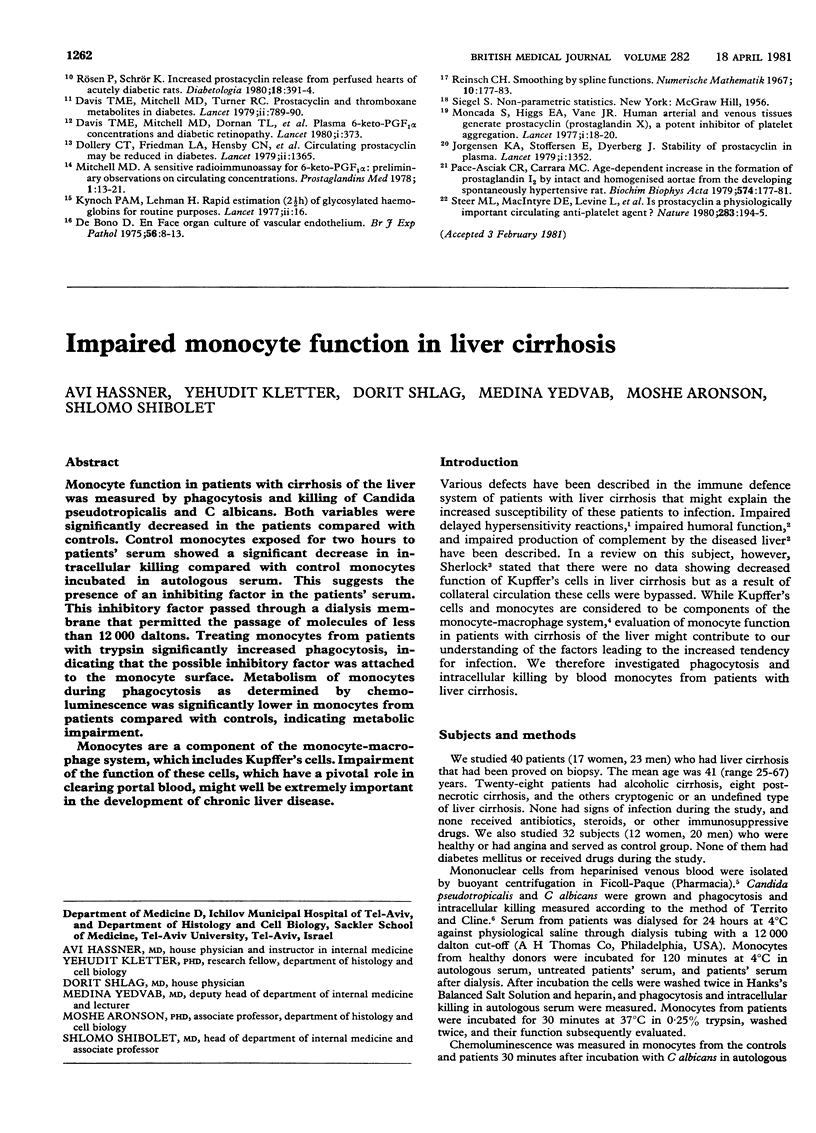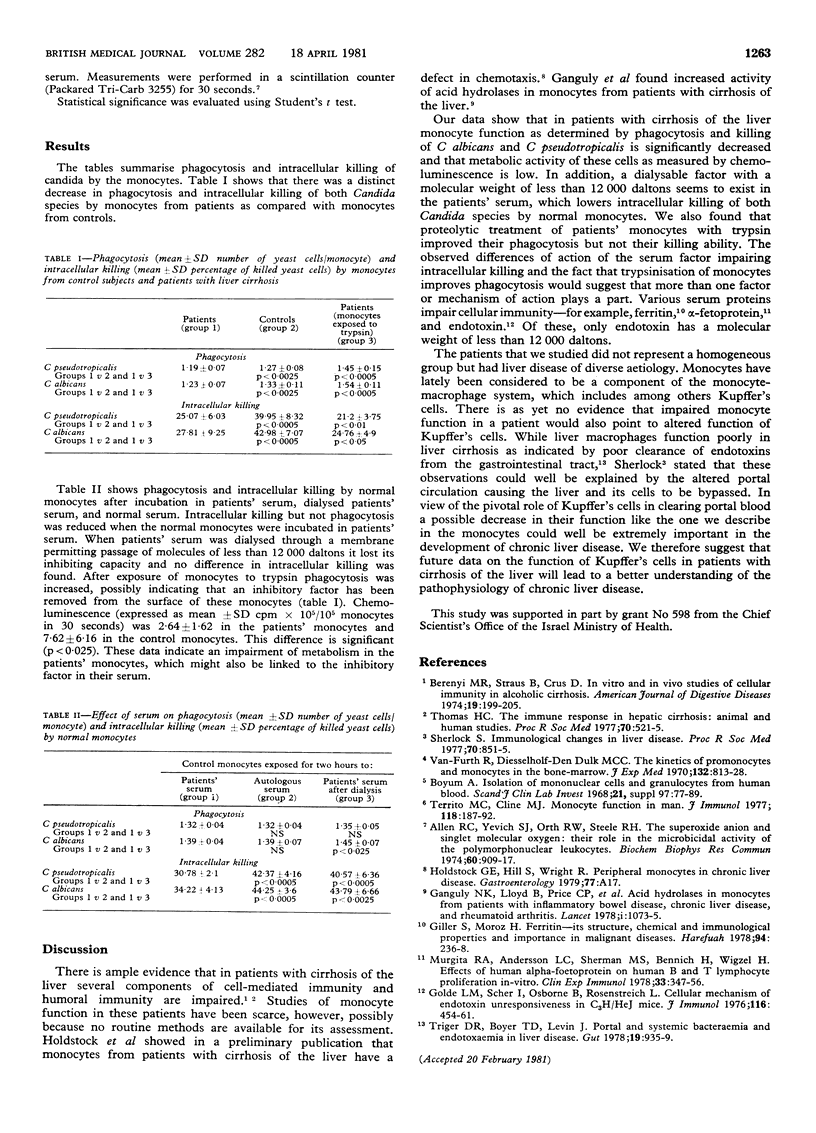Abstract
Monocyte function in patients with cirrhosis of the liver was measured by phagocytosis and killing of Candida pseudotropicalis and C albicans. Both variables were significantly decreased in the patients compared with controls. Control monocytes exposed for two hours to patients' serum showed a significant decrease in intracellular killing compared with control monocytes incubated in autologous serum. This suggests the presence of an inhibiting factor in the patients' serum. This inhibitory factor passed through a dialysis membrane that permitted the passage of molecules of less than 12 000 daltons. Treating monocytes from patients with trypsin significantly increased phagocytosis, indicating that the possible inhibitory factor was attached to the monocyte surface. Metabolism of monocytes during phagocytosis as determined by chemoluminescence was significantly lower in monocytes from patients compared with controls, indicating metabolic impairment. Monocytes are a component of the monocyte-macrophage system, which includes Kupffer's cells. Impairment of the function of these cells, which have a pivotal role in clearing portal blood, might well be extremely important in the development of chronic liver disease.
Full text
PDF

Selected References
These references are in PubMed. This may not be the complete list of references from this article.
- Allen R. C., Yevich S. J., Orth R. W., Steele R. H. The superoxide anion and singlet molecular oxygen: their role in the microbicidal activity of the polymorphonuclear leukocyte. Biochem Biophys Res Commun. 1974 Oct 8;60(3):909–917. doi: 10.1016/0006-291x(74)90401-x. [DOI] [PubMed] [Google Scholar]
- Berenyi M. R., Straus B., Cruz D. In vitro and in vivo studies of cellular immunity in alcoholic cirrhosis. Am J Dig Dis. 1974 Mar;19(3):199–205. doi: 10.1007/BF01072535. [DOI] [PubMed] [Google Scholar]
- Böyum A. Isolation of mononuclear cells and granulocytes from human blood. Isolation of monuclear cells by one centrifugation, and of granulocytes by combining centrifugation and sedimentation at 1 g. Scand J Clin Lab Invest Suppl. 1968;97:77–89. [PubMed] [Google Scholar]
- Ganguly N. K., Kingham J. G., Lloyd B., Lloyd R. S., Price C. P., Triger D. R., Wright R. Acid hydrolases in monocytes from patients with inflammatory bowel disease, chronic liver disease, and rheumatoid arthritis. Lancet. 1978 May 20;1(8073):1073–1075. doi: 10.1016/s0140-6736(78)90917-0. [DOI] [PubMed] [Google Scholar]
- Giller S., Moroz H. [Ferritin--its structure, chemical and immunological properties and importance in malignant diseases]. Harefuah. 1978 Apr;94(7-8):236–238. [PubMed] [Google Scholar]
- Glode L. M., Scher I., Osborne B., Rosenstreich D. L. Cellular mechanism of endotoxin unresponsiveness in C3H/HeJ mice. J Immunol. 1976 Feb;116(2):454–461. [PubMed] [Google Scholar]
- Murgita R. A., Andersson L. C., Sherman M. S., Bennich H., Wigzell H. Effects of human alpha-foetoprotein on human B and T lymphocyte proliferation in vitro. Clin Exp Immunol. 1978 Aug;33(2):347–356. [PMC free article] [PubMed] [Google Scholar]
- Sherlock S. Immunological changes in liver disease. Proc R Soc Med. 1977 Dec;70(12):851–855. [PMC free article] [PubMed] [Google Scholar]
- Territo M. C., Cline M. J. Monocyte function in man. J Immunol. 1977 Jan;118(1):187–192. [PubMed] [Google Scholar]
- Thomas H. C. The immune response in hepatic cirrhosis: animal and human studies. Proc R Soc Med. 1977 Aug;70(8):521–525. [PMC free article] [PubMed] [Google Scholar]
- Triger D. R., Boyer T. D., Levin J. Portal and systemic bacteraemia and endotoxaemia in liver disease. Gut. 1978 Oct;19(10):935–939. doi: 10.1136/gut.19.10.935. [DOI] [PMC free article] [PubMed] [Google Scholar]
- van Furth R., Diesselhoff-Den Dulk M. M. The kinetics of promonocytes and monocytes in the bone marrow. J Exp Med. 1970 Oct 1;132(4):813–828. doi: 10.1084/jem.132.4.813. [DOI] [PMC free article] [PubMed] [Google Scholar]


